Vietnam offers Taiwanese travelers a vibrant mix of rich culture, delicious cuisine, and stunning natural beauty. From bustling cities like Hanoi and Ho Chi Minh City to peaceful beaches in Phu Quoc and scenic mountains in Sapa, Vietnam is an affordable and welcoming destination. Taiwanese tourists enjoy easy visa procedures, warm hospitality, and diverse experiences that suit all travel styles.
Visa Requirements for Taiwanese Citizens
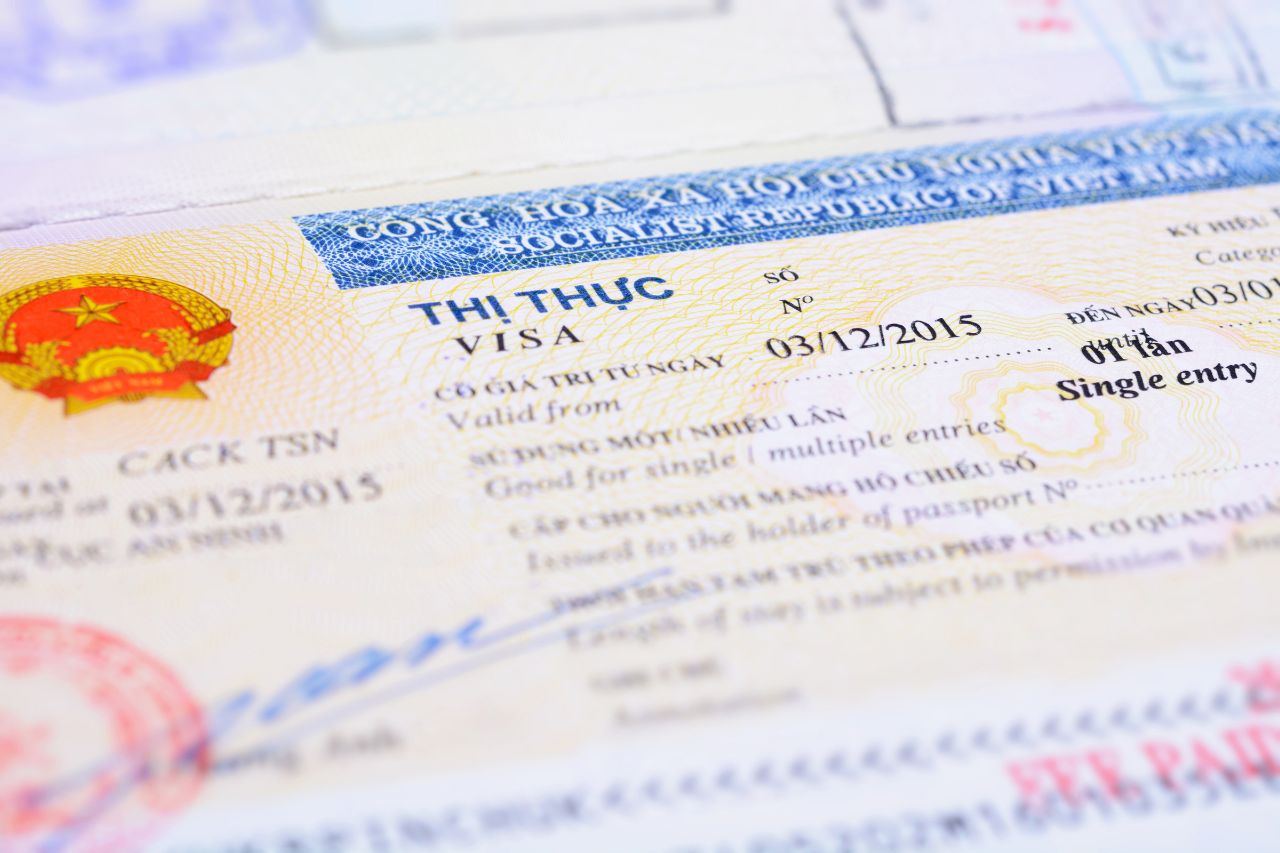
Taiwanese passport holders need a visa to enter Vietnam – there is no automatic visa exemption for Taiwan. Fortunately, Vietnam’s electronic visa (e-visa) system makes the process convenient. As of August 15, 2023, Vietnamese e-visas are available to citizens of all nationalities (including Taiwan) for tourist stays up to 90 days, with single or multiple entry options. You can apply online through Vietnam’s official immigration e-visa portal by uploading a passport scan and photo and paying the US $25 fee (for single entry) by card. Ensure your passport is valid at least 6 months beyond your arrival date (with blank pages for stamps). Standard e-visa processing takes about 3–5 working days, so apply at least a week or two before your trip. Once approved, you’ll receive a PDF visa to print out and show on arrival.
Tip: Vietnam’s e-visa allows entry at multiple airports and land/sea crossings. If your travel plans change, you can enter on any date within the approved visa validity (but not before). For last-minute trips or if the e-visa website is down, you could use a visa-on-arrival service through a Vietnam travel agency – you’ll get a pre-approval letter and then stamp the visa at the airport on arrival. However, visa on arrival is only available at international airports and usually not needed now that the e-visa is widely available. In summary, plan ahead and get your e-visa online to have a smooth entry into Vietnam.
Flights from Taiwan to Vietnam
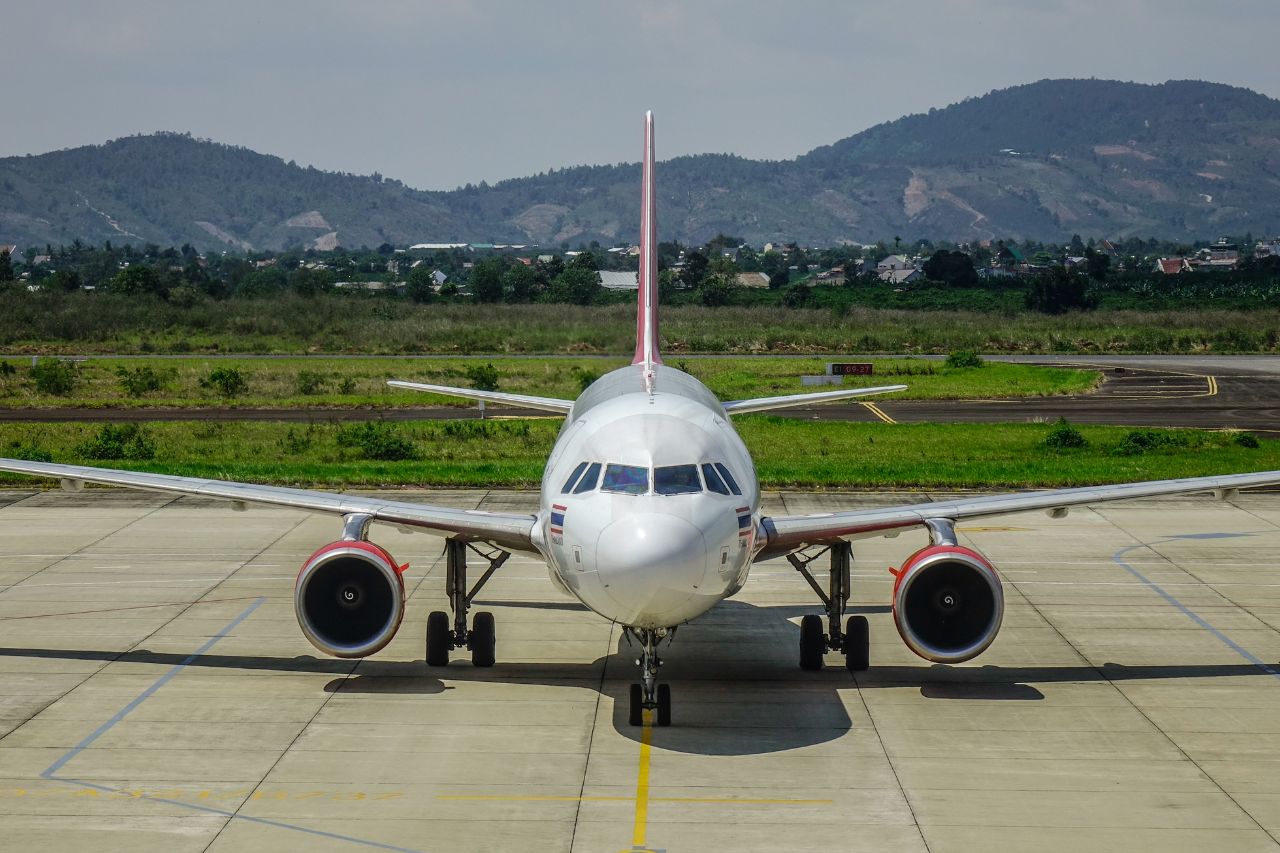
Traveling from Taiwan to Vietnam is straightforward with many direct flights. Major carriers operate daily routes from Taipei (Taoyuan International) and Kaohsiung to Vietnam’s biggest cities. For example, from Taipei to Hanoi, popular airlines include EVA Air, China Airlines, VietJet Air, and Vietnam Airlines. For Taipei to Ho Chi Minh City (Saigon), you’ll find nonstop flights on EVA Air and Taiwan’s new STARLUX Airlines, among others. Flight times are around 3 to 3.5 hours.
Most flights from Taiwan land in Vietnam’s primary international airports: Noi Bai Airport (HAN) in Hanoi for northern Vietnam, Tan Son Nhat Airport (SGN) in Ho Chi Minh City for the south, and Da Nang Airport (DAD) in central Vietnam (gateway to Hoi An). For instance, China Airlines and VietJet offer direct flights to Da Nang, which is convenient if your itinerary focuses on Hoi An or the central region. Round-trip fares can vary by season and airline, but competitive deals are often available – it’s common to find tickets in the range of NT$7,000–12,000 (US $250–400).
When planning your flights, also consider open-jaw options (e.g. fly into Hanoi and out of Ho Chi Minh City) to avoid backtracking. Vietnam is a long country, and if you plan to visit both north and south in one week, an internal flight (e.g. Danang to Ho Chi Minh City) might be worthwhile to save time. Major Vietnamese airlines (Vietnam Airlines, VietJet, Bamboo Airways) have frequent domestic flights that are relatively inexpensive. Travel tip: For budget-conscious travelers, VietJet Air often has promo sales, but note their baggage policies and potential delays. Overall, with multiple airlines and routes, you’ll have no trouble finding a flight schedule that fits your one-week Vietnam adventure.
Weather and Best Time to Visit

Vietnam’s climate is diverse, so the best time to visit depends on the region. Broadly, the dry season from November to April offers the most pleasant weather across the country. During these months, the north is cool and dry, the south is warm and rain-free, and the central coast enjoys sunny days – making it an ideal period for travel. By contrast, May to October is generally the rainy season in many areas, with hot, humid weather and monsoon rains.
- Northern Vietnam (Hanoi, Ha Long Bay, Sapa): Distinct four seasons. Winter (Dec–Feb) can be cool/cold in Hanoi (temperatures ~15°C, with Sapa even dropping below 10°C) – pack a jacket if visiting in Jan/Feb. Summer (May–Aug) is hot (30°C+) with heavy rains and occasional typhoons in late summer. The best time for the north is often spring (Mar–Apr) or autumn (Oct–Nov), when you get mild temperatures and clearer skies. For example, Sapa’s famous rice terraces are a vibrant green in summer, but September is harvest time when the terraces turn golden – a stunning sight if you don’t mind some rain. Autumn in Hanoi (Oct) is famously pleasant with cooler nights and lotuses blooming. Avoid late June–August in the north if possible, as heat and humidity are high and Ha Long Bay cruises may be disrupted by storms.
- Central Vietnam (Hoi An and surrounds): Has a slightly different weather pattern. Hoi An, Da Nang, and Hue are usually hot and dry from February to August (great beach weather in spring and summer). However, central Vietnam’s rainy season hits around September to November – this period brings heavy downpours and even floods; Hoi An’s old town sometimes floods in Oct due to river overflow. The best time for Hoi An is February–early August: early spring offers moderate temperatures, while summer is hotter but good for beach time (just prepare for heat around 35°C in June/July). If you visit in late January or February, you might catch the Lantern Festival in Hoi An’s old town during the full moon – the weather is generally comfortable then. Avoid October in central regions if possible, due to rain and typhoons.
- Southern Vietnam (Ho Chi Minh City, Mekong Delta, Phu Quoc): Tropical climate year-round. Rather than four seasons, the south has two: dry season (roughly December to April) and rainy season (May to November). Temperatures are consistently warm (around 28–34°C). The dry months (late Dec through March) are ideal – expect hot days, cooler nights and very little rain, perfect for city sightseeing and island hopping. By contrast, the rainy season peaks from June to August with daily afternoon thunderstorms; humidity is high, but showers tend to be short. Phu Quoc Island and the southern beaches have their best weather November to March, with calm seas and clear skies. In the wet season, Phu Quoc sees rougher seas and some resorts close; however, prices are lower and crowds thinner.
In summary, if you’re planning a one-week trip covering multiple regions, December to March would hit a sweet spot of good weather north to south (this is also peak tourist season). April and May can also be decent compromise months – rain is not yet heavy, and you’ll enjoy lush landscapes and slightly fewer tourists than winter. Whenever you go, check the specific forecasts for each destination and pack accordingly (layers for the north, rain jacket if in monsoon season, sun protection year-round). And don’t worry – Vietnam is an year-round destination to some extent: even in the “worst” weather months, you can still find pleasant conditions in one part of the country, so you can adjust your itinerary to chase the sun!
Vietnamese Culture and Customs

Vietnamese culture shares some similarities with other East Asian cultures, yet it has its own distinct etiquette that travelers should respect. The society places great emphasis on politeness, respect for elders, and community harmony. Here are a few cultural customs and tips to keep in mind during your visit:
- Greetings and politeness: A friendly “Xin chào” (hello) paired with a smile goes a long way. Many Vietnamese, especially younger people, will shake hands when greeting foreigners – use both hands or support your right elbow with your left hand for extra respect in formal settings. It’s polite to give a slight bow of the head when greeting older people. Always address elders and officials with respect; if you learn a couple of phrases like “cảm ơn” (thank you) and “xin lỗi” (sorry), locals will appreciate the effort. Avoid overly aggressive or loud behavior – raising your voice or showing anger is considered impolite and can cause loss of face. Direct confrontation is avoided in Vietnam’s etiquette, so try to stay calm and courteous if you encounter any issues.
- Dress modestly in temples and rural areas: While casual attire is fine in cities or beach areas, be mindful to cover your shoulders and knees when visiting temples, pagodas or someone’s home in the countryside. Pack a light scarf or shawl to throw on when needed. If you visit religious sites (like Huế’s imperial tombs or local temples), remove your hat and take off your shoes if required (you’ll usually see a pile of footwear at the entrance). In general, modesty is respectful in Vietnam – flashy or revealing outfits might draw unwanted attention except on the beach.
- Customs and etiquette: The Vietnamese concept of “saving face” means people strive to avoid embarrassment or confrontation. You’ll notice locals are generally humble and soft-spoken in public. A few do’s and don’ts: Do smile and say hello to vendors or people you meet – Vietnamese are friendly and a smile creates goodwill. Do use both hands to give or receive things (especially gifts, money, or business cards). Don’t point with your index finger – use your whole hand to gesture. Don’t touch someone’s head (even little kids) as it’s seen as rude. When dining, it’s polite to let elders take food first; also don’t stick chopsticks upright in your rice bowl (it resembles incense for the dead). If you’re invited to a Vietnamese home, bring a small gift (fruit, sweets) and remove your shoes at the door. At temples, speak quietly and don’t flash your camera in people’s faces during worship.
- Interactions and language: English is not universally spoken, but in touristy areas many people (especially younger folks) know basic English. Few Vietnamese speak Mandarin, so Taiwanese visitors might rely on English or translation apps. Learning a couple of Vietnamese words is fun – “xin chào” (hello), “cảm ơn” (thank you) – and will delight locals. When bargaining or resolving misunderstandings, stay patient and humorous rather than pushy. Vietnamese people are generally warm and welcoming to foreign guests – showing respect and interest in their culture will be returned with kindness and helpfulness.
In short, be polite, flexible, and observant of how locals behave. If unsure, mimic what locals do (whether it’s how to queue for the bus or how to properly hold incense at a temple). The Vietnamese will appreciate your efforts to understand their customs, and you’ll have more meaningful interactions during your trip.
Must-Try Vietnamese Cuisine
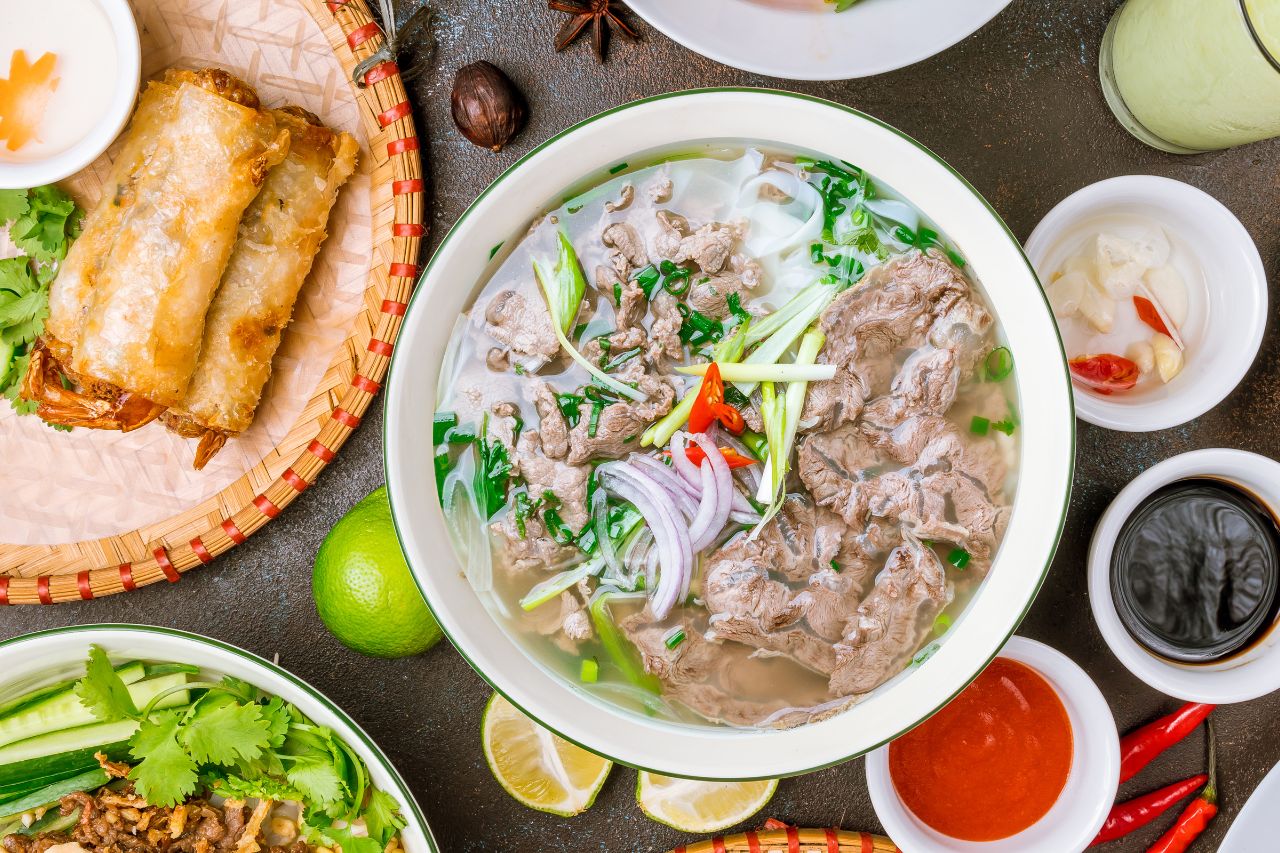
One of the highlights of visiting Vietnam is undoubtedly the food. Vietnamese cuisine is famous for its balance of flavors – aromatic herbs, fresh ingredients, and a mix of influences from north to south. For Taiwanese travelers, many dishes will feel comforting (like noodle soups and rice dishes) but also excitingly new with local twists. Here are some must-try dishes and regional specialties you should seek out:
- Phở – Vietnam’s most famous dish. This is a warm noodle soup typically with beef (phở bò) or chicken (phở gà). Northern-style phở (as found in Hanoi) has a clear, savory broth flavored with star anise, ginger, and cinnamon, and is usually less sweet than southern versions. In the south (Saigon), phở broth may be a bit sweeter and they’ll serve it with a basket of fresh herbs, bean sprouts, and lime. Enjoy phở as locals do – often for breakfast! Squeeze in lime, add chili or garlic vinegar to taste, and slurp away. A bowl of phở from a street stall is not only delicious but very affordable.
- Bún chả – A Hanoi specialty you shouldn’t miss when in the capital. It consists of grilled pork patties and slices served in a bowl of tangy-sweet fish sauce broth, with a side of rice vermicelli noodles and heaps of fresh herbs. You dip the noodles and herbs into the bowl to eat. The smoky charcoal-grilled pork paired with garlic, chili, and herb flavors is phenomenal. Fun fact: Bún chả was the dish President Obama famously ate with Anthony Bourdain in Hanoi. Look for it at street-food eateries in the Old Quarter – you’ll often spot a small grill outside loaded with sizzling pork.
- Chả cá Lã Vọng – Another Hanoi classic: turmeric-marinated fish (usually catfish) fried tableside with dill and spring onions, eaten with rice noodles and peanuts. It’s an iconic dish (so famous that a street in Hanoi is named after it) and offers a unique blend of flavors – aromatic dill and fish sauce. If you’re a seafood lover, put this on your list.
- Bánh mì – Vietnam’s answer to the sandwich, reflecting its fusion of French and Vietnamese influences. A crispy-on-the-outside, fluffy-inside baguette is filled with things like sliced pork or pâté, pickled carrot and daikon, cucumber, cilantro, chili and a smear of mayo or chicken liver spread. Every region has its style: In Saigon, bánh mì tends to be more loaded with fillings (grilled pork, sausage, fried egg – you name it), whereas Hội An’s famous Bánh Mì Phượng adds unique homemade sauces. It’s the perfect quick meal or snack on the go. Don’t be shy about trying roadside bánh mì carts – they’re cheap and among the tastiest street foods.
- Hue and Hoi An specialties: Central Vietnam has its own cuisine influenced by the imperial cuisine of Huế and local tastes. If you pass through Huế (or see central-style restaurants), try Bún bò Huế, a robust spicy beef noodle soup with lemongrass – it’s bolder and spicier than phở, often including beef slices, pork leg, and even congealed blood cubes (you can skip that if it’s not your thing!). In Hội An, the signature dish is Cao lầu, chewy rice noodles made with water said to be from ancient well water, topped with char siu pork, herbs, and crispy crackers. It’s a delicious mix of textures and reflects Chinese-Japanese influences on Hoi An cuisine. Also look for Mì Quảng, a turmeric-yellow noodle dish from Quảng Nam province (where Hoi An is) that’s served with just a bit of broth, pork, shrimp, peanuts, and rice crackers. These central dishes are flavor-packed – often a bit spicy, a bit smoky, truly memorable.
- Fresh spring rolls (Gỏi cuốn): A lighter bite that’s popular everywhere. These are translucent rice paper rolls filled with fresh greens, herbs, rice vermicelli, and typically shrimp and pork, served with a peanut dipping sauce. They’re soft, fresh, and a great appetizer or snack in Vietnam’s heat. Also try the fried version known as Chả giò (in the south) or Nem rán (in the north) – fried spring rolls filled with minced pork, mushroom, and veggies, often eaten wrapped in lettuce leaves. Crispy goodness!
- Bánh xèo – A must-try southern Vietnamese dish, though you can find it in most cities. Bánh xèo are large sizzling rice crepes colored yellow with turmeric, stuffed with shrimp, pork, and bean sprouts, fried until crispy. To eat, you cut or break off a piece, wrap it in a lettuce leaf or rice paper with herbs, and dip in fish sauce. It’s a fun, hands-on eating experience. The name bánh xèo means “sound cake” for the sizzle it makes on the pan!
- Cơm tấm – A Saigon specialty beloved by southern locals, perfect for lunch. It’s broken rice topped with grilled pork chops, a fried egg, and various pickled vegetables, served with a side of fish sauce for flavor. Despite using “broken” rice grains (considered lower-grade historically), the dish is so tasty it’s now a staple. The pork chop is often marinated in a sweet-savory mix and grilled to perfection – the combination with the rice, a bit of egg yolk, and fish sauce is comfort food at its best. Look for cơm tấm eateries in Ho Chi Minh City – often identified by the fragrant smoke of grilling meat on the sidewalk.
- Seafood – Given Vietnam’s long coastline, you should definitely sample the seafood. Each region has its special catch: in Hạ Long Bay, you might try grilled squid or steamed prawns on your cruise; in central beach towns like Đà Nẵng, fresh clams or snails cooked with lemongrass and chili are popular; and on Phú Quốc, don’t miss the chance to eat sea urchin or flower crab fresh from the ocean. Phú Quốc’s night market is famous for its seafood BBQ where you can pick your fish or crab and have it grilled on the spot.
- Vietnamese coffee & drinks: Coffee is practically its own food group in Vietnam! Vietnamese coffee (cà phê) is strong Robusta brew, typically served sữa đá (with condensed milk over ice) – a sweet, rich iced coffee that will energize you for your sightseeing. Also try cà phê trứng (egg coffee) in Hanoi – a creamy dessert-like coffee made with whipped egg yolk and sugar (tastes like tiramisu!). Vietnam is the world’s largest Robusta coffee exporter, and they know how to brew it in style; you can even buy the little metal drip filter (phin) and coffee grounds as a souvenir for ~US $5. Beyond coffee, quench your thirst with a fresh sugar cane juice (nước mía), or a young coconut water straight from the shell. If you enjoy beer, Bia hơi is the local fresh draught beer, prevalent in Hanoi – it’s light, cold, and insanely cheap (like 5,000₫ a glass at street corners). In the evening, unwind with a cold Saigon Special or 333 beer – Vietnamese beers are mild and go great with street food.
These are just a few of the culinary delights Vietnam offers – the list could go on (we haven’t even mentioned papaya salad (gỏi đu đủ), BBQ skewers (nem nướng), che desserts, and more!). A good strategy is to eat regionally: try the famous dishes in their home region for authenticity. And don’t be afraid of street food – it’s not only delicious but also a window into local life. Pull up a little plastic stool, grab a bowl of something steaming and aromatic, and enjoy! As a Taiwanese, you might find Vietnamese cuisine less oily and with lots of herbs, which makes it light yet flavorful. A bowl of phở or a bánh mì can be a comfort meal that still surprises your taste buds with new herbs like coriander, Thai basil, or fish-mint. Bon appétit, or as the Vietnamese say, Chúc ngon miệng! (enjoy your meal).
Major Destinations and Attractions
Vietnam offers a wealth of destinations, but in one week you’ll likely focus on a few key places. Below are highlights of the main tourist spots often included in a one-week Vietnam itinerary. You can mix and match based on your interests (e.g. culture, nature, beach), and how you connect them (by train, bus or plane) depending on time.
Hanoi Capital
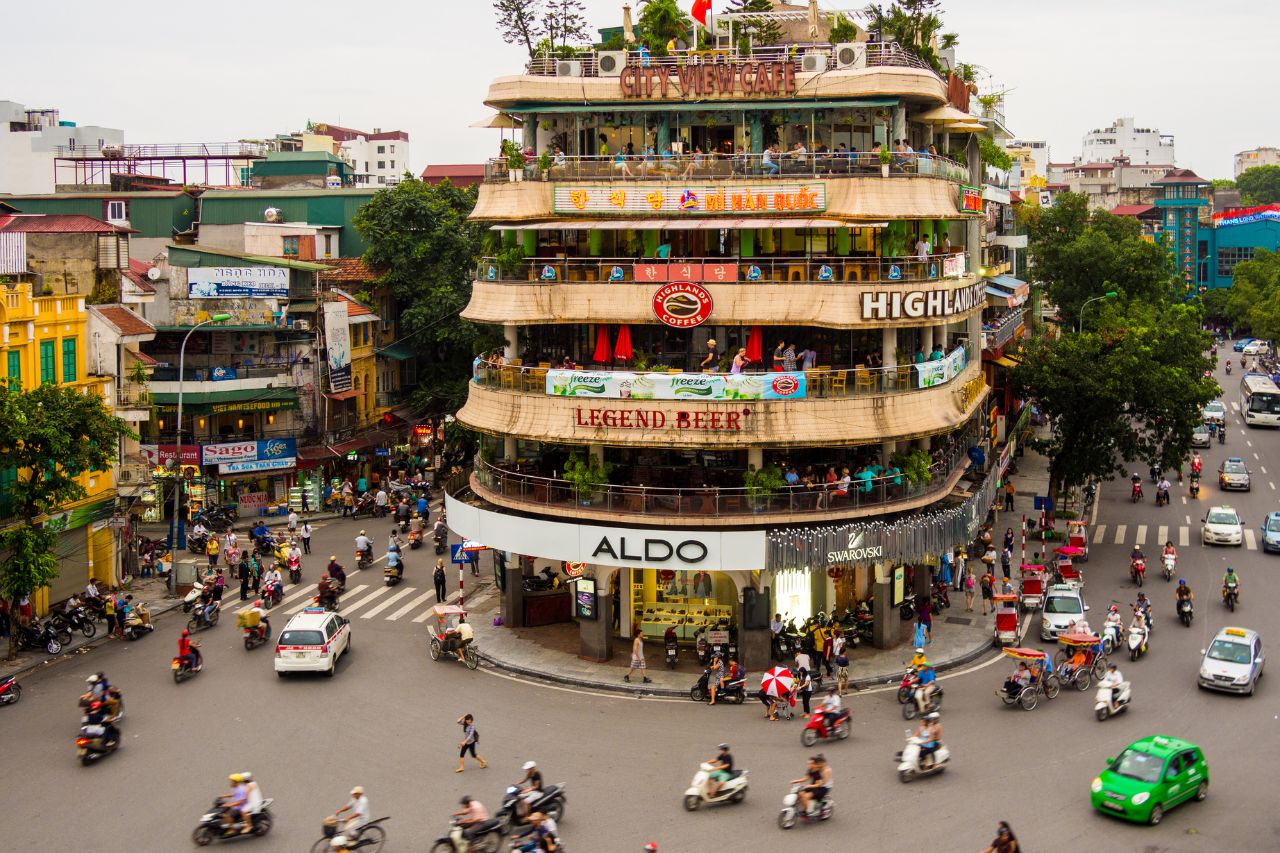
A bustling street in Hanoi’s Old Quarter, full of shops and motorbikes at dusk.
Vietnam’s capital is a city of timeless charm, blending ancient culture with modern energy. In the heart of Hanoi lies the Old Quarter, a maze of 36 historic streets each traditionally dedicated to a craft (silk, silver, paper, etc.). Strolling these narrow lanes, you’ll encounter colonial shophouses, street vendors with shoulder-pole baskets, roaring motorbikes, and hidden Buddhist temples – it’s a feast for the senses. Start at Hoàn Kiếm Lake, the central lake with the charming red Thê Húc Bridge leading to Ngọc Sơn Temple on a small island. The lake is not just scenic but deeply symbolic: according to legend, a golden turtle god emerged here to reclaim a sacred sword from King Lê Lợi after he defeated invaders, hence the name “Lake of the Returned Sword”. Every morning, locals gather by Hoàn Kiếm’s shore to do Tai Chi and exercises, giving you a glimpse into daily life.
From the lake, you can dive into history and culture. Don’t miss the Temple of Literature (Văn Miếu) – dating to 1070, it’s Vietnam’s first national university, dedicated to Confucius. Its walled courtyards and stone turtle steles exude tranquility amid the city. Another pilgrimage spot is the Ho Chi Minh Mausoleum in Ba Đình Square, where Vietnam’s revered leader “Uncle Ho” lies in state. Nearby, you can see the simple stilt house he lived in and the One Pillar Pagoda, a tiny wooden temple on a single stone pillar rising out of a lotus pond (a symbol of purity). For museum lovers, the Vietnamese Women’s Museum and Museum of Ethnology are highly recommended for insightful exhibits on culture and history (the Ethnology museum, in particular, showcases the diverse ethnic groups of Vietnam with life-size traditional house replicas).
Hanoi has plenty of French colonial architecture too – the St. Joseph’s Cathedral (reminiscent of Notre Dame de Paris) and the Hanoi Opera House painted in yellow & white grandeur, for example. If time permits, catch a traditional Water Puppet Show at Thăng Long Water Puppet Theatre by Hoàn Kiếm Lake. This unique art form, where wooden puppets dance on water to live music, originated in the Red River delta centuries ago and is a fun cultural experience (even if you don’t understand the language, the visuals are captivating).
A huge part of Hanoi’s charm is simply wandering and eating. As evening falls, head back to the Old Quarter: join the crowds at Bia Hơi Junction (Tạ Hiện Street) where nightly street “bars” serve fresh beer for cheap – a great place to mingle. The Old Quarter’s streets come alive with food stalls selling phở, bun chả, skewers, and more. Don’t forget to shop for souvenirs in the Old Quarter’s night market (weekends) – you’ll find everything from embroidery to coffee. Travel tip: Hanoi’s sidewalks can be chaotic (often overtaken by parked motorbikes and little plastic stools of food stalls). Embrace the chaos and do as locals do: walk on the street edge if needed, move confidently yet cautiously when crossing (vehicles will flow around you). It’s an adventure! Also, try the famous egg coffee at a cafe like Giảng or Đinh Café – sipping this creamy concoction on a balcony overlooking the lake or street is the perfect Hanoi moment.
Ha Long Bay
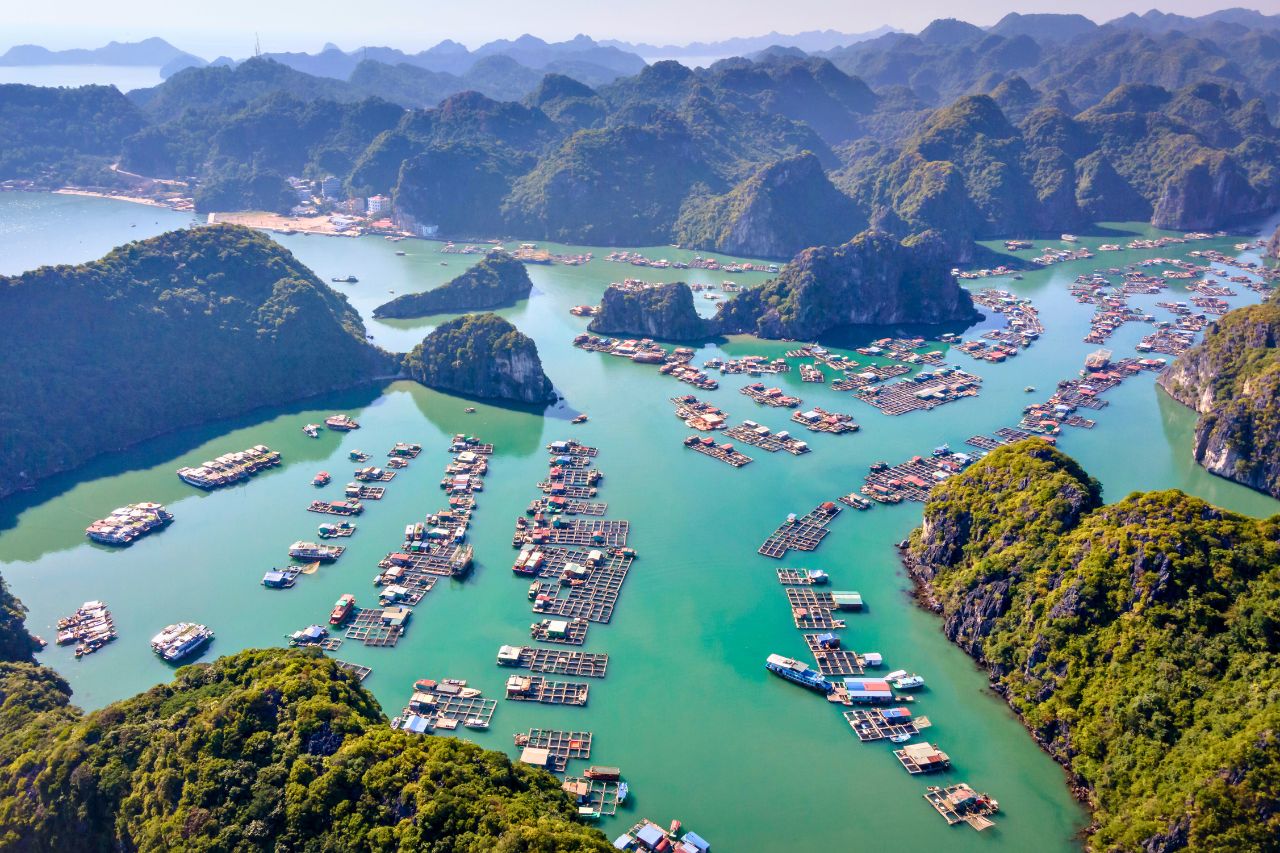
The breathtaking limestone karsts of Hạ Long Bay emerging from emerald-green waters.
A visit to northern Vietnam isn’t complete without witnessing the otherworldly beauty of Hạ Long Bay. This UNESCO World Heritage site spans a bay of approximately 1,500 square kilometers dotted with 1,600+ limestone islets rising dramatically from the sea. “Hạ Long” means descending dragon, stemming from a legend that a great dragon’s flailing tail created the bay’s valleys and peaks. The best way to experience Ha Long Bay’s magic is to join an overnight cruise and float among the karst formations. On a typical cruise, you’ll have a cozy cabin and be taken to highlights like Sửng Sốt (Surprise) Cave – a massive grotto filled with stalactites – or Thiên Cung (Heavenly Palace) Cave, as well as a stop at Ti Tốp Island where you can hike to a summit for a panoramic view or swim at a small beach. Kayaking is often on the agenda too – paddling into hidden lagoons or through sea arches gives you a peaceful, up-close encounter with the bay’s tranquility.
If you’re short on time, a day trip from Hanoi is possible (around 4 hours each way by road, so it makes a long day). But an overnight cruise is highly recommended to enjoy sunset, dawn, and a night on the water – it’s truly a memorable experience to see the karsts fade into silhouettes as the sun sets and then wake up to the bay shrouded in morning mist. Most cruises also serve excellent seafood meals (squid, prawns, fish freshly caught) – dining on the deck under the stars is quite enchanting. For the more adventurous, some tours offer rock climbing or visiting less touristy areas like Bái Tử Long Bay (adjacent to Ha Long, similarly beautiful but quieter).
Keep in mind the weather – Ha Long Bay can be chilly and foggy in winter (Dec–Feb), which gives an ethereal atmosphere but sometimes limited visibility. In summer (May–Sep), the skies can be clearer blue, but there’s a chance of trips being canceled due to storms or typhoons. Always have a buffer day or be flexible if you can, since safety comes first and authorities will halt cruises if the weather is dangerous. Tip: Bring motion sickness medicine if you’re prone – the bay waters are usually calm, but it’s better to be safe. Also, pack a swimsuit (for a dip or kayaking) and insect repellent for evenings on deck. Hạ Long Bay is one of those places that live up to the hype – sailing among these mythical-looking islands is sure to be a highlight of your Vietnam trip.
Sapa Town
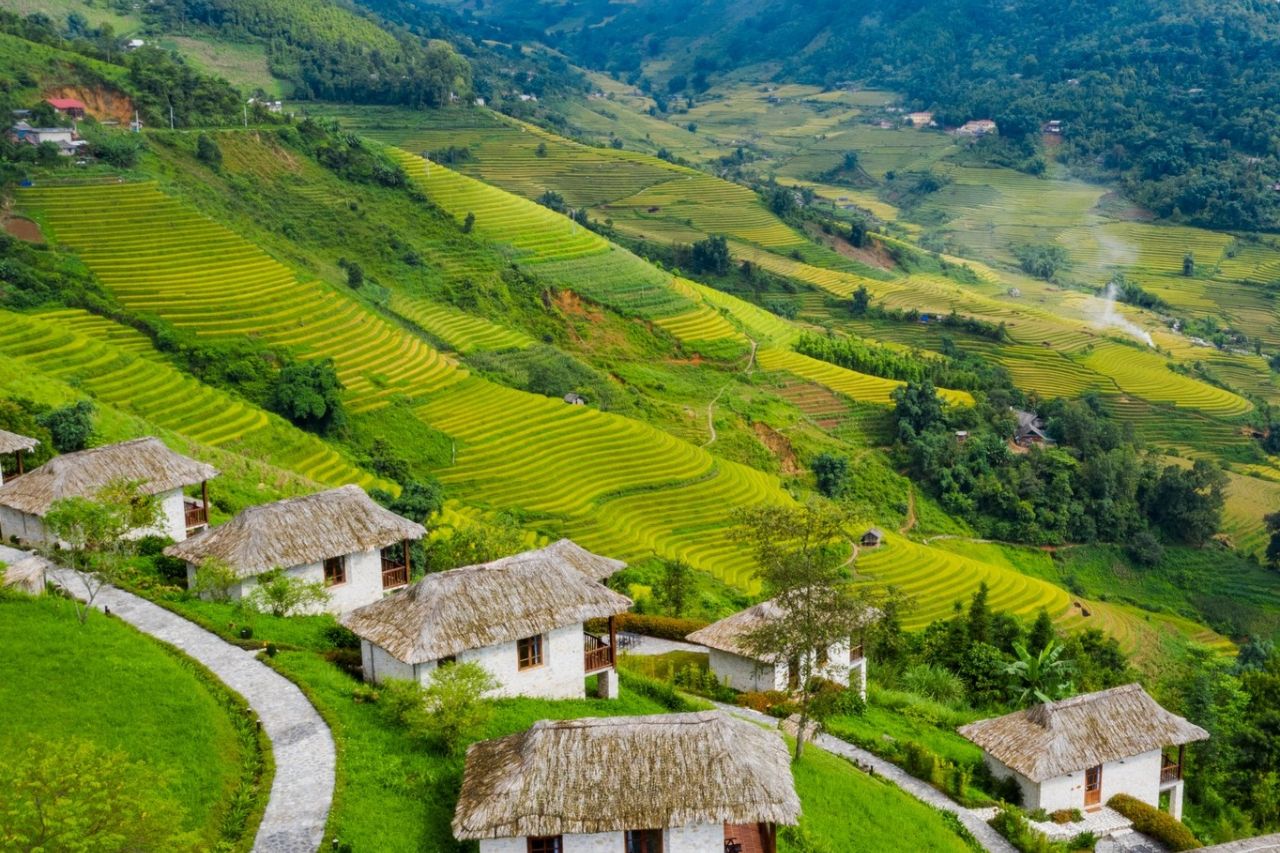
Lush green rice terraces and misty mountains in Sapa’s Muong Hoa Valley.
If you love mountains and culture, Sa Pa in northwest Vietnam is a must-visit. This highland town (at ~1,500m elevation) was a French hill station and today is famous for its terraced rice fields, ethnic minority villages, and cool climate. The journey to Sapa from Hanoi takes ~5–6 hours by bus or an overnight sleeper train to Lào Cai followed by a short bus ride – it’s a bit of a trek, so ideally you’d spend at least 2 days/1 night here as part of your week.
The quintessential Sapa experience is trekking through the rice terraces of the Mường Hoa Valley, visiting local villages of the H’Mong, Dzao, and other tribes. With a local guide (often from those communities), you can hike to villages like Cát Cát, Lao Chải, Tả Van, or Sin Chải, passing cascading paddy fields that change color with the seasons (emerald green in summer, golden in autumn). You’ll meet local farmers in traditional dress and perhaps be invited to their homes or to try a cup of ruou gao (rice wine). A popular short walk is from Sapa town to Cát Cát Village (about 3 km), which has a picturesque waterfall and handicraft stalls (admittedly a bit touristy but still beautiful scenery). For a more authentic trek, the longer routes to Tả Van or up the mountain trails are rewarding – consider an overnight homestay in a village for a deeper experience.
Towering over Sapa is Fansipan, nicknamed “the Roof of Indochina”. At 3,143m, it’s the highest peak in Vietnam and indeed all of Indochina. If you’re fit and have an extra day, you can trek Fansipan with a guide (it’s a strenuous 2-day hike). But nowadays most visitors opt for the Fansipan Cable Car, which in 15 minutes whisks you almost to the summit. From the upper station, you climb about 600 steps to the very top, where a viewing platform and monument await. On a clear day, the panoramic views of mountains and clouds are breathtaking – standing above the clouds is quite an experience. At the top, you’ll also see a large golden Buddha statue and pagoda that have been built, adding a spiritual ambiance. Note that it’s much colder and windier up on Fansipan, so bring a warm jacket.
Back in Sapa town, you can visit the Stone Church (a mini Gothic church in the town center) and shop for local crafts in the market – think embroidered textiles, silver jewelry, or indigo-dyed clothing made by the ethnic minority artisans. The town has many cozy cafes (try a mountain-grown herbal tea or the locally-grown arabica coffee) and restaurants where you can taste specialties like thắng cố (a traditional H’Mong stew) or the more tourist-friendly salmon hotpot – yes, Sapa raises cold-water salmon and sturgeon in farms, and a steaming hotpot is perfect for the chilly climate.
One delightful aspect of Sapa is the weather – it’s refreshingly cool compared to Hanoi. In summer, expect mild temperatures (~20°C), while in winter it can drop to near freezing at night (Sapa occasionally even sees frost or snow flurries in Dec/Jan!). Pack some warm layers. The cool air, mist rolling over the terraces in the early morning, and dramatic peaks make Sapa feel almost like a different world from the lowlands. Tip: Do hire a local guide (many young H’Mong girls speak good English) for trekking – not only for navigation, but they will share insights about their culture and help you interact respectfully with villagers. And be prepared that you might be approached by village ladies selling handicrafts; a polite “no, thank you” works if you’re not interested, but if you do like something, a purchase is a nice way to support the community (bargain gently and good-humoredly). All in all, Sapa offers a balance of natural beauty and cultural richness – it’s often a favorite memory for travelers who venture there.
Hội An Ancient Town

Hội An’s Ancient Town aglow with colorful lanterns during the monthly Lantern Festival.
If you ask tourists their favorite place in Vietnam, many will name Hội An – and for good reason. This UNESCO World Heritage town is a perfectly preserved trading port from the 15th-19th centuries, showcasing a fusion of Vietnamese, Chinese, and Japanese architecture. The Ancient Town’s signature mustard-yellow shophouses, wooden facades, and decorative lanterns make it absurdly picturesque both day and night. It’s a small town, so you can wander freely (much of the old quarter is pedestrian-only in the evenings).
Major sights are within walking distance: The iconic Japanese Covered Bridge (Chùa Cầu) is Hội An’s symbol, built by the Japanese community in the 1590s to connect their neighborhood to the Chinese quarter. It’s a beautiful wooden bridge with a pagoda roof – fun fact: it’s depicted on Vietnam’s 20,000₫ currency note. Your entry ticket to the old town (120,000₫, about NT$160) lets you visit a number of heritage buildings. Some must-sees: Old House of Tấn Ký – a merchants’ home with antique decor surviving 7 generations; Phúc Kiến Assembly Hall – an ornate Chinese community hall/temple with dragon fountains; and the Museum of Trade Ceramics which gives context to Hội An’s trading past. However, the real joy is simply soaking up the atmosphere: every street corner is photogenic, from the Central Market by the Thu Bồn River – where you’ll find fresh vegetables, fish, and street food stalls – to the handicraft shops and tailors for which Hội An is famous.
Indeed, tailor-made clothing is a highlight here. Hội An’s tailors are renowned for quickly whipping up suits, dresses or even traditional áo dài dresses to your measurements, often overnight. If you’ve ever wanted custom clothing at a fraction of the cost back home, this is the place. Choose fabrics at the Hội An Cloth Market or let the tailor suggest; they will measure you and you’ll come for a fitting the next day. It’s quite fun and the results are great value (remember to bargain politely). Popular tailor shops include Yaly, A Dong Silk, but there are many – check reviews or start with something simple. Tip: If you do want clothes made, go on your first day in Hội An to allow time for adjustments.
One of Hội An’s most enchanting experiences is the nighttime lantern scene. Every night, especially on the 14th of the lunar month (full moon), the old town is illuminated by thousands of lanterns. The electricity-dimmed streets take on a warm glow, and locals release paper lanterns with candles onto the river for good luck. You can even take a short boat ride on the Thu Bồn River under the moonlight and floating lanterns – it’s somewhat touristy but undeniably romantic and beautiful. (Full moon nights also come with traditional performances and all motorized boats are banned for an hour or two as only hand-rowed sampan boats glide on the water among the lanterns). Even if you’re not there on the exact lantern festival date, Hội An at night is magical any day – colorful lamps hang from every building and reflect in the water.
Aside from heritage and tailor shops, food is a star in Hội An. Make sure to try Cao lầu noodles and White Rose dumplings (delicate shrimp dumplings) which are local specialties. Also, Hội An has some famous eateries: Bánh Mì Phượng for the sandwich, Morning Glory or Mermaid restaurant for local dishes, and the Night Market across the river on An Hội islet for street eats and souvenirs (lots of lantern vendors here too – the collapsible silk lanterns make great gifts). During the day, if you want a break from sightseeing, you can bike to An Bàng Beach (5km away) to relax by the sea, as many travelers do (bikes can be rented for a dollar or many hotels have them free). Or take a fun cooking class – many start with a market tour and boat ride, then hands-on making spring rolls, papaya salad, etc., a delightful way to spend half a day.
In summary, Hội An is atmospheric and laid-back. It’s small enough that you feel relaxed (especially since no scooters are allowed in the center during certain hours), and it offers a great mix of culture, shopping, food, and photogenic scenery. It tends to be a trip favorite, so allocate at least 1–2 full days if you can. Early mornings are quiet and great for photos before day-trippers arrive. And at night, allow yourself to get lost in the lantern-lit alleys – it’s a travel experience you won’t forget.
Ho Chi Minh City (Saigon)

Ho Chi Minh City’s modern skyline at night, including the Bitexco Financial Tower (tallest round building).
Vietnam’s largest metropolis, often still called Saigon by locals, is a bustling, dynamic city of skyscrapers, French colonial architecture, and motorbikes zipping everywhere. Ho Chi Minh City (HCMC) offers a fascinating contrast to Hanoi – it’s more modern and sprawling, with a fast-paced vibe. In one or two days, you can cover the major sights and get a taste of Saigon’s energy.
Start at the city center (District 1): here you’ll find the grand Notre-Dame Cathedral (built in 1880, currently under renovation but still an icon) and right across from it, the Central Post Office, designed by Gustave Eiffel – a beautiful colonial building where you can actually mail a postcard home. Strolling Dong Khoi Street (formerly Rue Catinat) will show you chic boutiques, the Saigon Opera House (another elegant colonial edifice), and luxury hotels like the Continental (of The Quiet American fame). History enthusiasts should head to the War Remnants Museum, a powerful museum documenting the Vietnam War from the Vietnamese perspective. It houses intense photographs and artifacts (from Agent Orange effects to tiger cages) – a somber but important stop to understand Vietnam’s recent history. Note: some exhibits are graphic and can be emotionally heavy.
Another historical site is the Independence Palace (Reunification Palace) – the 1960s-modernist palace where the Vietnam War effectively ended when tank 843 crashed through the gates in 1975. You can tour the preserved meeting rooms and the underground bunkers; it’s like a time capsule of 1970s decor. Outside, you’ll even see replica tanks on the lawn.
For a change of pace, dive into Saigon’s markets. The most famous is Bến Thành Market, a symbol of the city with its clock-tower gate – inside is a maze of stalls selling everything from coffee, dried fruits, spices to souvenirs, clothes and textiles. It’s hectic, but fun to bargain and browse (expect initial prices high, bargain down maybe 50% if you’re buying souvenirs). By evening, the streets around Bến Thành transform into a night market with pop-up street food eateries and vendors – a great place to try southern dishes and snag some last-minute gifts. Another interesting market is Chợ Bình Tây in Cholon (Saigon’s Chinatown, District 5) – a more local wholesale market in a beautiful oriental-style hall; while there, also visit the Thiên Hậu Temple, a Chinese temple with hanging spiral incense coils.
If you’re interested in the war history further, make time for a half-day trip to the Củ Chi Tunnels outside the city (~1.5 hours drive). This is an underground network of tunnels used by Viet Cong soldiers – you can actually crawl through a widened section of the tunnels to feel how claustrophobic it was, and see traps and bunkers they used. It’s quite touristy but very insightful. Some tours even let you (for a fee) fire a rifle at the shooting range afterward, but that’s optional. If you go, bring mosquito spray and prepare to get a bit dirty from the tunnel crawl.
For a glimpse of modern Saigon, check out the Bitexco Financial Tower’s Skydeck (or the newer Landmark 81 building if you’re a skyscraper fan). At Bitexco, there’s an observation deck and also a bar (Eon51) where you can sip a cocktail with a panoramic view of the sprawling city – best visited around sunset to see the city light up. You might be surprised at how developed parts of HCMC look, with glittering malls and high-rises.
By night, HCMC offers a lot of fun. Backpacker street Bùi Viện in District 1 is the equivalent of Bangkok’s Khao San – a neon-lit stretch of bars, clubs, street food and throngs of people. It’s noisy and not very “Vietnamese” authentic, but if you’re in the mood for nightlife, it’s an experience (you’ll see everything from cheap beer promos to loud music and dancing). For something more low-key, the Nguyễn Huệ Walking Street is an open promenade where families, friends, and tourists congregate in the evenings, often with impromptu performances or people riding hoverboards – at the top of it is a statue of Ho Chi Minh in front of the colonial People’s Committee Building, which is beautifully lit at night.
Food-wise, Saigon is a paradise. As a big city, it has not only southern specialties (like cơm tấm, bánh xèo, hủ tiếu noodle soup) but also regional foods – you can find excellent Hanoi-style phở and Hue spicy beef soup here too. Must-tries in Saigon: sip a cà phê sữa đá in one of the stylish cafes (the cafe scene is huge here, from hipster hideouts to traditional sidewalk cafés with little stools). And enjoy the street food – look for a bustling spot and try whatever they’re serving. District 4 is famed for seafood street stalls (try ốc – various snails/clams in tamarind sauce or grilled scallops). And dessert: Saigon has fantastic tropical fruits; get a fruit smoothie or a bowl of chè (sweet dessert soup) with ingredients like beans, jellies and coconut milk, perfect to beat the heat.
Ho Chi Minh City can feel overwhelming with its traffic (the swarms of motorbikes are legendary), heat, and crowds. But it’s also vibrant and cosmopolitan, showing you urban Vietnamese life. As a Taiwanese visitor, you might find echoes of Taipei’s buzz here, though the cityscape and culture are distinct. Embrace the hustle for a day or two – by the time you leave, you might find you’ve grown fond of the energy and even the ordered chaos of Saigon’s streets.
Phú Quốc Island

The tranquil white sands and turquoise water of Bãi Sao beach, Phú Quốc – an island paradise.
To round out your Vietnam trip with some relaxation, Phú Quốc is the perfect island escape. Phú Quốc lies off the southwestern coast (actually closer to Cambodia) and is Vietnam’s largest island, renowned for its white-sand beaches, clear waters, and laid-back vibe. In one week, you’d likely fly here (about a 1-hour flight from HCMC). The moment you arrive, you’ll notice the pace slows down – exactly what you want at the tail end of a busy trip.
Beaches: Phú Quốc has many beaches, but two of the most popular are Long Beach (Bãi Trường) and Sao Beach (Bãi Sao). Long Beach runs along the western side near most resorts and the main town (Dương Đông). It’s great for sunsets and swimming, with plenty of beachfront bars and eateries – you can enjoy a cocktail watching the sun dip into the Gulf of Thailand. Sao Beach, on the southeast, is often touted as the most beautiful: powdery white sand and calm turquoise water. It’s a bit further from town but worth the trip (go in the morning for fewer people). Another increasingly popular spot is Ông Lang Beach on the west (quieter, undeveloped vibe) and Gành Dầu in the north (you can see Cambodia’s coastline from there).
Island activities: Beyond lazing on the sand, Phú Quốc offers fun outings. A highlight is snorkeling or diving around the An Thới Archipelago (a cluster of small islands to the south). Join a boat tour and you’ll island-hop to spots like Hòn Móng Tay (Finger Island) or Hòn Thơm, where you can snorkel over coral reefs and see colorful fish. The waters are warm and clear, especially in dry season. Some tours include fishing or a BBQ on the boat. Scuba diving operators also cater to beginners if you want an intro dive. Another must-do is taking the Hòn Thơm Cable Car – this is one of the world’s longest sea-crossing cable cars, stretching almost 8km from Phú Quốc to Hòn Thơm island! The ride is spectacular with aerial views of emerald isles and fishing boats below. At Hòn Thơm, there’s now a water park and entertainment area, or you can just enjoy the beach there and return.
On the island itself, consider visiting a pepper farm – Phú Quốc is famous for its pungent black pepper. Peppercorns are dried in the sun and you can buy some as an aromatic souvenir. Likewise, Phú Quốc is known for its fish sauce (nước mắm) production – the island’s fish sauce is reputedly the best, thanks to high-quality anchovies. There are fish sauce factory tours, where you’ll see giant wooden barrels fermenting the fish. (The smell is intense! But it’s interesting to see how this quintessential Vietnamese ingredient is made. Keep in mind you usually cannot carry fish sauce on airplanes due to its pungency – consider buying tightly sealed bottles in checked luggage if at all).
Nature lovers might venture to Phú Quốc National Park in the northern half of the island – you can do a gentle hike to waterfalls like Suối Tranh or Suối Đá Bàn, or visit the protected forest area (not a lot of big wildlife, but nice for a nature walk if you’re bored of beaches). Another poignant site is the Phú Quốc Prison Museum (Nhà Tù Phú Quốc), also known as Coconut Tree Prison – used during the Vietnam War to detain POWs. It has exhibits and mannequins illustrating the harsh conditions. It’s a quick but sobering visit that adds historical context to an island otherwise known for leisure.
Nightlife and food: In the evenings, head to the Phú Quốc Night Market in Dương Đông town. It’s a lively scene with dozens of stalls offering fresh seafood – think huge tiger prawns, squid, sea snails, grilled scallops with green onion, and the local specialty sea urchin grilled with scallion oil and peanut (nếu bạn thích). You can pick what you want and have it cooked on the spot. The market also sells ice cream rolls, smoothies (try a sapodilla or soursop shake), and souvenirs like pearls (Phú Quốc has pearl farms too). It’s touristy but a lot of fun to browse and eat – best to go around 6–7 PM when the seafood is freshest and the lanterns and lights are just coming on. If you prefer a sit-down meal, many resorts and beach bars do seafood BBQ buffets as well. Don’t miss trying gỏi cá trích (raw herring salad), a Phú Quốc specialty – thin slices of herring are mixed with coconut, onion, chili and wrapped in rice paper, dipped in spicy sauce. It’s much tastier than it sounds!
Phú Quốc is all about relaxation. Spend your days sunbathing, swimming, maybe getting a massage or spa treatment at your resort. Rent a motorbike or take a taxi to explore different beaches. Enjoy a beachside hammock and coconut drink. The island vibe will recharge you after the more hectic city stops. Keep in mind the best season is Nov–Apr when the sea is calm; in the monsoon months (Jul–Oct) some tours might not operate due to rough waters, and some beaches (especially on the west) can get less clear. But even in rainy times, there are sunny breaks and you can find sheltered corners on the east coast.
As a final note, Phú Quốc is duty-free and even has a visa waiver for international tourists (30 days visa-free if you enter Phú Quốc directly, which some regional flights do). For you coming from Taiwan, you’d likely connect via HCMC or Hanoi so the general visa rules apply, but it’s interesting to know. The island is rapidly developing, so go sooner rather than later if you want to catch its remaining natural charm. All in all, it’s a perfect last stop to unwind on tropical beaches and reflect on your Vietnam journey.
Shopping Tips and Souvenirs
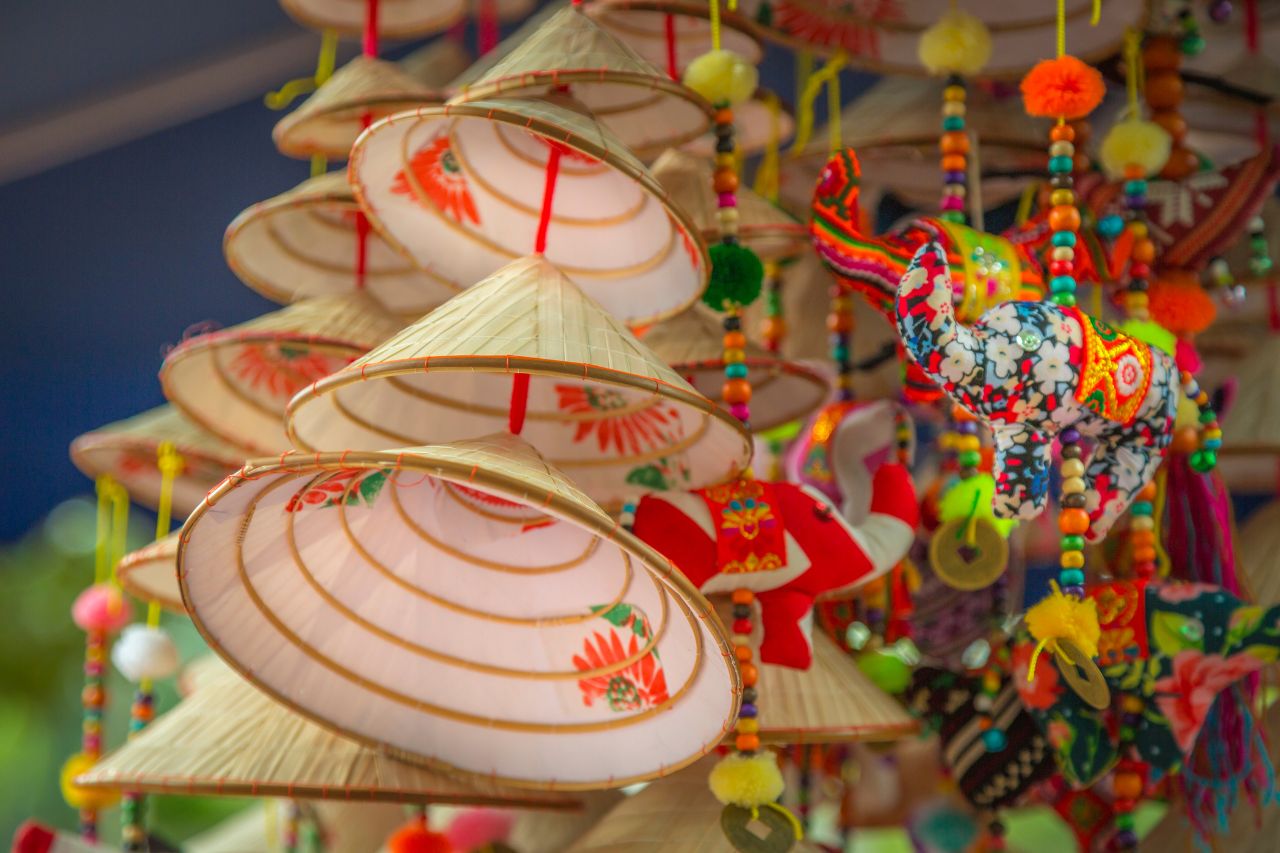
Vietnam is a shopper’s delight, with everything from bustling markets to boutique handicraft stores. For Taiwanese travelers, you’ll find prices generally quite affordable – and don’t forget to leave room in your luggage for some great finds. Here are shopping highlights and tips:
- Traditional Souvenirs: Take home a piece of Vietnamese culture with items like tribal textiles, silk products, lacquerware, and coffee. In Hanoi’s Old Quarter, you’ll find streets specializing in these goods – for example, Hàng Gai street has silk shops selling scarves, ties, and tailored áo dài. Vietnamese silk is high quality and reasonably priced. Lacquerware (bowls, plates, vases with inlaid mother-of-pearl or painted scenes) is a beautiful and distinctive craft – just ensure you pack it well to avoid damage. If you venture to Sapa or Mai Châu, look for embroidered fabrics or bags made by ethnic minorities; each group has unique patterns. Vietnam is also famous for ceramics (try Bát Tràng pottery village near Hanoi or shops in Hội An) and wooden carvings. And of course, the iconic nón lá conical hat – light, cheap, and the ultimate Vietnamese symbol – makes for a fun wall decoration back home.
- Edible Gifts: Many travelers load up on Vietnamese coffee. As mentioned, Vietnam is a top coffee exporter (especially robusta beans). You can buy packed coffee beans or grounds (Trung Nguyên is a popular brand, or Highlands Coffee). Don’t forget the little metal phin filter to drip-brew your coffee the authentic way – available at markets for a couple of dollars. Tea is another option (lotus tea from Hanoi, artichoke tea from Dalat, or jasmine tea). For something uniquely Vietnamese: Phú Quốc pepper (fragrant black peppercorns) – a prized spice, or cinnamon from the northwest highlands. Cashew nuts from Bình Phước province are also excellent (Vietnam is a big cashew producer). And if your friends have a sweet tooth, pick up coconut candy from Bến Tre or packets of dried fruits (sweet dried jackfruit, mango, or banana chips) from supermarkets. A pro tip: you might see “weasel coffee” (cà phê chồn) for sale – coffee beans that have been digested by civet cats. It’s like the Vietnamese version of Indonesia’s kopi luwak. It’s quite expensive and an acquired taste; ensure it’s authentic if you splurge, as cheap versions may be fake.
- Arts and Handicrafts: Vietnam has a thriving art scene. You can find beautiful propaganda poster reproductions (with bold graphics of wartime or socialist slogans – they make quirky decorations). Hanoi has plenty of art galleries where you might buy an original painting or a copy of a famous one (Vietnamese lacquer painting is something special). For something small, hand-painted ceramics, bamboo and rattan woven items (like baskets, placemats), or embroidered items (tablecloths, silk pictures) are plentiful. Chopsticks carved from wood or bamboo, often sold in sets with mother-of-pearl inlay, are lightweight souvenirs (and every time you use them for dinner you’ll remember your trip).
- Clothing and Tailoring: As mentioned, Hội An is the place for custom tailoring. In addition, you can buy ready-made clothes in Vietnam cheaply – for instance, light cotton summer dresses, t-shirts with fun prints, or the traditional áo dài. The quality varies, but in places like Saigon’s Saigon Square or big markets, you can find export overruns of garments (sometimes from global brands) at good prices. Shoes in large sizes might be limited, but you’ll find plenty of knock-off sneakers in markets (quality not guaranteed). If you’re into outdoor gear, check out stores like North Face outlets in Hanoi – many are factory surplus (or sometimes convincing fakes) but much cheaper than abroad.
- Pearls and Jewelry: If you go to Hạ Long Bay or Phú Quốc, you’ll encounter pearl farms. Vietnam produces cultured pearls (especially Akoya and South Sea types). You can get pearl earrings or necklaces at decent prices – just buy from a reputable shop to ensure they’re real. Similarly, silver jewelry is popular (Sapa’s minority markets sell tribal-style silver bracelets; Hội An has some nice jewelry stores with modern designs too).
Shopping Tips: Bargaining is expected in markets and with street vendors. Start by offering perhaps half the quoted price and negotiate to meet somewhere in between – do it with a smile and good humor. Gentle haggling is part of the fun in Vietnam’s markets, but if you feel uncomfortable or the price is already clearly marked (in malls, convenience stores, or some souvenir shops), then it’s fixed. It helps to carry Vietnamese đồng in small notes for purchases (1 USD ≈ 24,000 ₫). Some vendors in touristy areas may accept U.S. dollars, but the rate won’t be great – better to use local currency.
Be mindful of fake branded goods; you’ll see plenty of “Rolex” watches for $20 or “North Face” jackets for $15. Buy them only if you just like the look and don’t care about authenticity. For higher value items (like antiques or art), get the necessary paperwork if you plan to bring them out of the country. Vietnam has restrictions on exporting real antiques.
Tax and duty: Vietnam has relatively low prices, and as a tourist you can get VAT refunds at the airport for big purchases (above 2 million VND in one invoice at qualified stores). The process can be a bit of a hassle, though, so most people only bother if they bought expensive items.
In all, enjoy the hunt for unique souvenirs. Whether it’s a kilo of coffee beans, a hand-embroidered wall hanging, or simply a conical hat you bargained for at a market, each item will carry memories of your trip. Plus, shopping in Vietnam often doubles as a cultural experience – you’ll interact with local vendors, practice a bit of language and bargaining, and perhaps gain insight into Vietnamese craft traditions and daily life.
Budget for a One-Week Trip
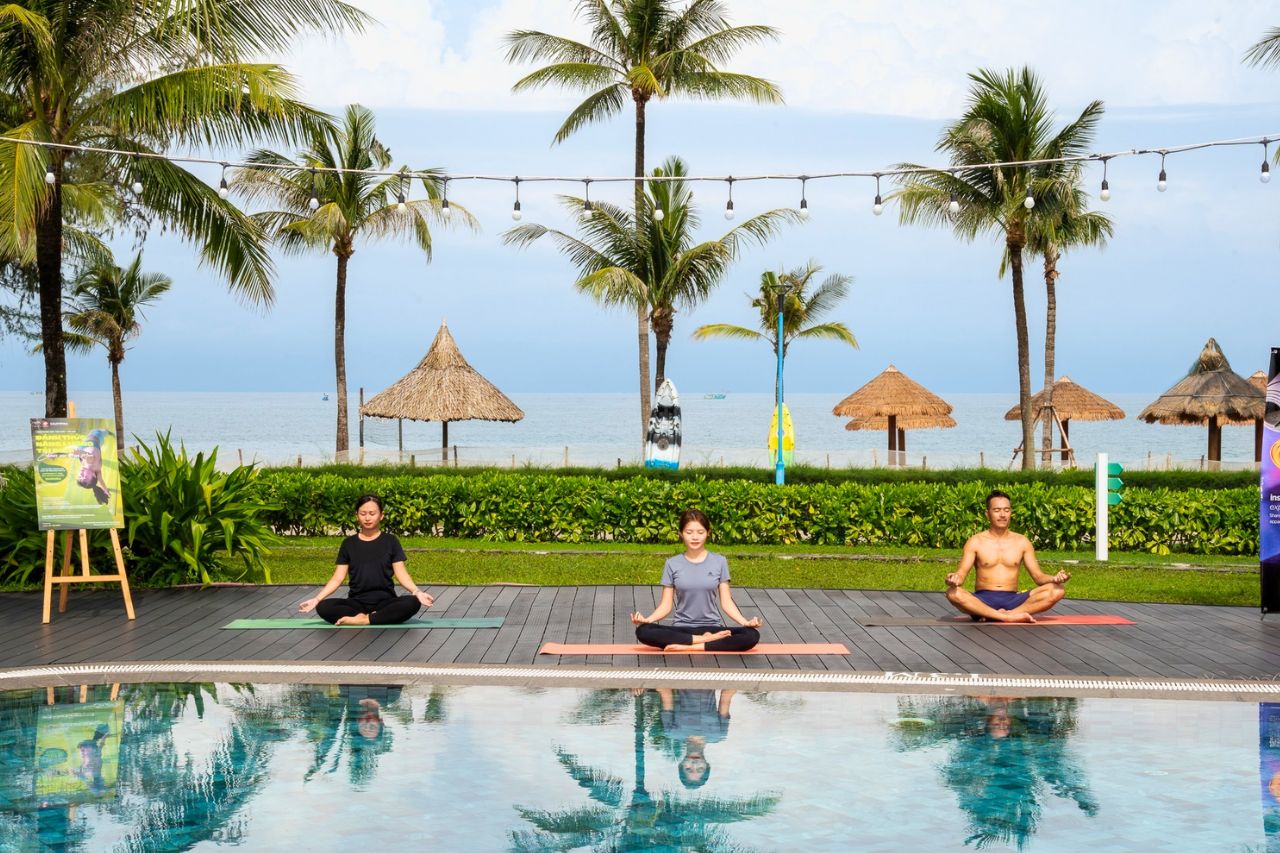
One of the great things about Vietnam is that it caters to all budgets – you can travel very affordably or live it up in luxury, and in both cases get good value. Below is a breakdown of typical expenses and a suggested budget for a 1-week trip, assuming you’re a mid-range traveler (not backpacking on the absolute cheap, but also not staying at 5-star resorts every night).
- Flights: Your international flight from Taiwan will likely be the biggest single expense. As mentioned, round-trip fares might be around NT$8,000–12,000 (US $270–400) depending on season and airline deals. For budgeting, let’s say ~NT$10,000 (US $350) for flights per person (it could be less if you snag a promo). If you plan to take a domestic flight within Vietnam (e.g. Hanoi to Da Nang, or Da Nang to HCMC), add about US $50–100 per one-way flight, depending on how early you book and the airline. Overnight trains or buses are cheaper (a soft sleeper train Hanoi to Da Nang is around $40), but may eat into your limited time.
- Accommodation: Vietnam offers a wide range. Budget hostels or guesthouses can be as low as $10–15 per night (NT$300–450) for a basic room or dorm bed. Mid-range boutique hotels or nice 3-star hotels often range $30–60/night (NT$900–1800) and often include breakfast. For instance, a comfortable hotel in Hanoi or HCMC city center might be around $40 a night. Resorts or high-end hotels could be $80–150+ per night. Assuming mid-range, you might budget about $40–50 per night for accommodation, which over 7 nights = $280–350 (roughly NT$8,500–10,500). Two people sharing a room can split that. If you mix – maybe a couple nights in a splurge resort in Phú Quốc and simpler stays elsewhere – adjust accordingly. Many travelers find accommodation in Vietnam great value, with even budget hotels offering clean rooms, A/C, private bathrooms, free Wi-Fi, etc.
- Food: Vietnamese street food and local restaurants are delicious and inexpensive. A bowl of phở might be 40,000₫ (NT$50). Banh mì sandwich 20,000₫ (NT$25). Even a meal at a sit-down local restaurant is often under 100,000₫ (NT$130) per person. If you dine at more upscale restaurants or those aimed at tourists, it might be 200,000–300,000₫ (NT$260–390) per meal. Let’s average it out: say $15–20 per day on food covers three meals and snacks generously if you’re eating local. That’s about $100–140 for a week (NT$3,000–4,200). If you enjoy alcohol, add a bit more: a beer is cheap (~20k₫ NT$25 at street stalls, maybe NT$60–80 in bars), but cocktails or wine in nice bars can be closer to NT$200–300 each. Coffee, tea, smoothies are often NT$40–60. So even with indulgences, food & drink might be $150 for the week on a mid-range plan.
- Transportation: Within cities, taxis and ride-hailing apps (Grab) are plentiful and cheap. A 3 km taxi ride might be 50,000₫ (NT$65). Taking a GrabBike (motorbike taxi via app) is even cheaper and an adventurous way to beat traffic – just a dollar or two for short hops. In one week, city transport might total $20–30. If you’re transferring between cities: a tourist bus from Hanoi to Sapa ~ $15 one-way; Hanoi to Halong Bay tour bus maybe $10; a train from Da Nang to Hue $5; internal flights $50+. It depends on your itinerary. Let’s allocate $50–100 for in-country transport (buses, trains, taxis) for the week if doing multiple stops. If you join group tours (which include transport), that will be counted in activity costs.
- Activities and Entrance Fees: Many sights are very cheap to enter – Temple of Literature 30k₫ (NT$40), War Remnants Museum 40k₫, Hoi An old town ticket 120k₫. The priciest things are typically package tours or excursions: an overnight Halong Bay cruise can range from $100 (budget boat) to $150–200+ (luxury) per person – but that includes transport, lodging on boat, food. A guided day trip to Cu Chi Tunnels might be $20–30. A cooking class in Hoi An $30–40. The Fansipan cable car about 750k₫ ($50) and some smaller entries, maybe $100–150 covers a week’s worth of sightseeing and tours. If you’re backpacking very cheaply, you could spend far less (many free experiences like wandering Old Quarter or beaches), or if you do multiple expensive tours (say Halong cruise + seaplane flight or something), it could be more. But a moderate estimate is ~$100 for attractions/tours.
- Shopping and Miscellaneous: This part is very subjective! If you plan to get clothes tailored, that might be $30–100 per garment. Souvenirs could add up if you buy coffee, art, etc. Let’s say $50–100 for souvenirs and treats. Also include perhaps a SIM card ($10 for 5-10GB data, easily obtained at the airport or shops) so you can use Grab and Google Maps. And maybe a cushion for massage/spa – a nice spa treatment might be $20–30 for an hour. Budget a bit for contingencies (medicine, laundry, tips). Tipping isn’t big in Vietnam except maybe rounding up for exceptional service or leaving a small tip for guides and hotel staff if you like. A common practice is to tip tour guides about $3-5 per day of tour, and perhaps $1 for hotel porters. It won’t break the bank, but good to have some small notes handy.
Putting it together for one person (in USD):
- Accommodation: ~$300 (mid-range hotels)
- Food & drinks: ~$140
- Local transport: ~$50
- Activities/entries: ~$120
- Souvenirs/misc: ~$80
That totals around $690, plus international airfare. Round up a bit and you have roughly $750–800 (about NT$22,500–24,000) for a comfortable one-week trip (excluding the flight from Taiwan). This aligns with about $100–120 per day for everything on the ground, which indeed is a very comfortable budget in Vietnam. You can certainly do it for less: backpackers might spend as little as $30–50 a day by staying in hostels (NT$300), eating street food (NT$150/day), and using buses. That could be <$300 for a week excluding flights – extremely affordable. On the flip side, luxury travelers can find wonderful high-end experiences (5-star hotels, private tours, fine dining) and could spend $200+ a day easily – but even that often costs less than equivalent in other countries.
To summarize, for mid-range travelers a realistic budget is around US $600–800 (NT$18k–24k) per person for one week in Vietnam, not including international airfare. Including a flight estimate, maybe NT$30,000 (US ~$1000) total. This would cover a mix of 3–4-star hotels, domestic transport, a couple of guided tours, lots of good food, and some shopping. Many people find they spend even less once there because day-to-day expenses are lower than expected – so you might come home with some money left or simply spend more on shopping and spa indulgences!
Money tips: The Vietnamese Đồng can be confusing at first due to many zeroes. As of now, 1 TWD ~ 750 ₫, and US $1 ~ 24,000 ₫. You’ll be dealing in thousands: 100,000₫ is roughly NT$130 (US$4). Credit cards are accepted in hotels, big restaurants and shops in cities, but many transactions (taxis, street food, market buys) are cash only. ATMs are widespread in cities if you need to withdraw – common ones are Vietcombank, Techcombank, etc., and they often dispense 2,000,000₫ at a time (~US$85) with a small fee. It’s wise to carry various denominations; pay big things with 500,000₫ notes, but keep smaller notes like 20k, 50k for street vendors and taxis (many small vendors can’t break large notes easily). Overall, Vietnam is budget-friendly, and with prudent spending you’ll find your money goes a long way while still enjoying the best the country has to offer.
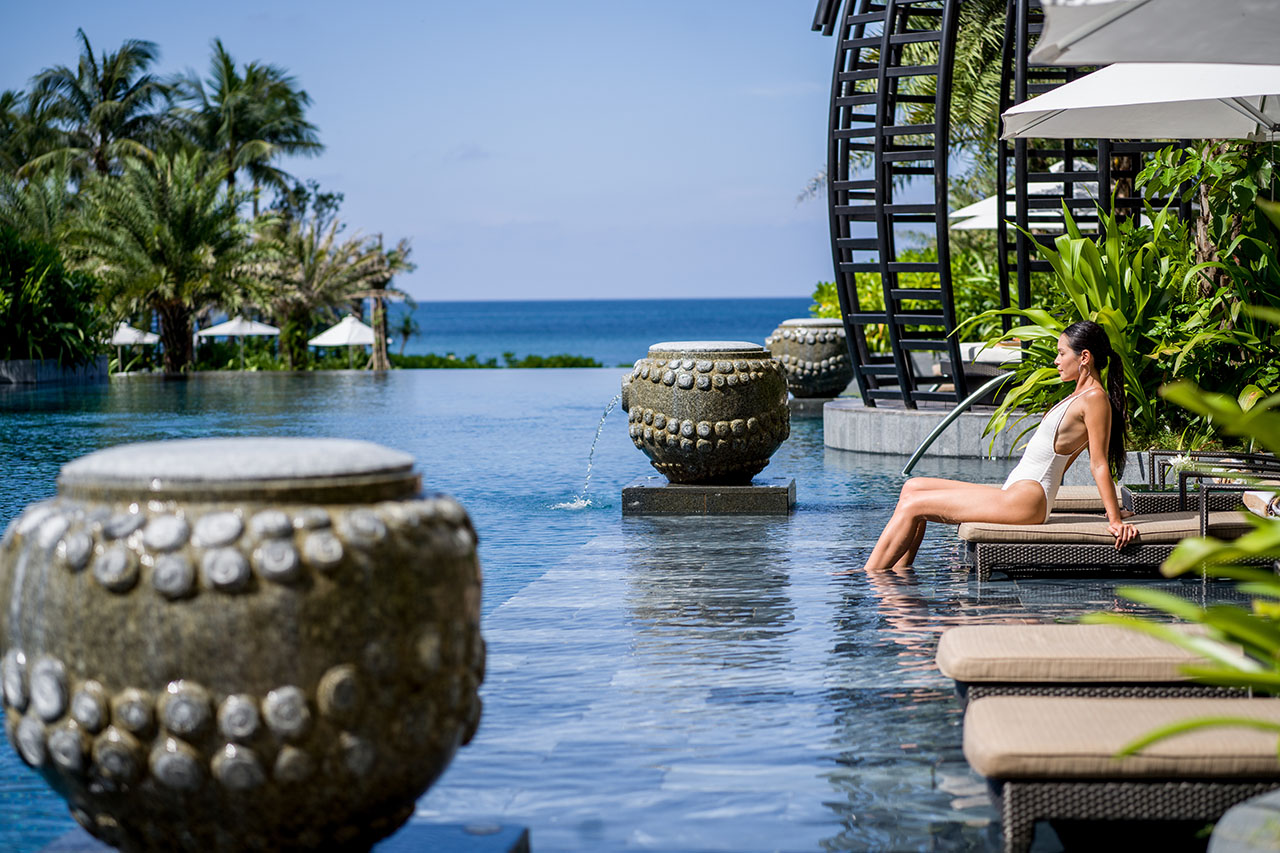
Traveling in Vietnam is an exciting experience – from the vibrant streets of Hanoi and Saigon to the peaceful bays and beaches. In one week, you’ll get a taste of the country’s diversity: its history, food, natural beauty, and warm hospitality. This guide should equip you with the essentials for planning, but stay flexible and embrace the surprises along the way. Taiwanese visitors often find Vietnam friendly and accessible, yet full of delightful differences to explore. Chúc bạn có một chuyến đi vui vẻ! (Wish you a happy trip!)

